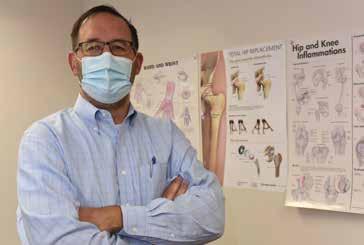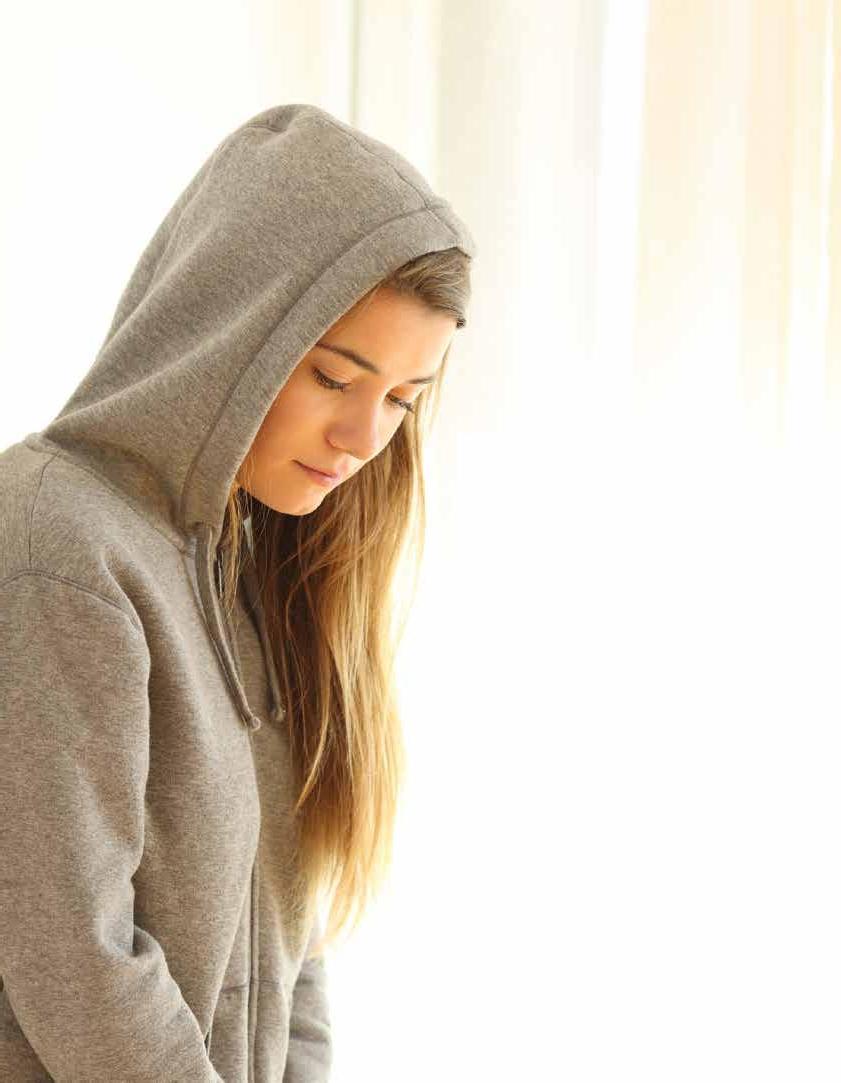
15 minute read
From The Charlton School
“PARENTING is the easiest thing in the world to have an opinion about, but the HARDEST thing in the world to do.” – Matt Walsh
Having children is an amazing experience… parents watch them grow through a series of cognitive, physical, emotional, and behavioral stages and achieve developmental milestones along the way. The paradigm shifts for parents when they recognize “little differences” in their child that separate them from others. In response to this awareness, the course of action parents choose to take can vary from looking at the difference and questioning if it needs to be looked at more closely or looking beyond the difference and hoping it will correct itself.
Even with the great strides Americans have made in recent decades in becoming aware of childhood mental health conditions, there’s still too great a number of children and adolescents who go without the help they need. This is concerning when experts tell us there are high risk factors associated with not getting needed treatment early-on. One of the reasons why finding treatment is delayed is that there is an ongoing stigma that surrounds mental and behavioral issues in children. Parents often struggle with shame, fear, and guilt - feeling as though they failed their kid in some way. All these factors affect a parent’s ability to trust where they should send their child to address the issues at hand. What follows is a real-life story, the second, in an ongoing series of four. The story tells of a family who has a 15-year-old, whose Mom described as “a creative child, who is a great thinker and very verbal.” At some point in the schooling process the student was discovered to have learning issues. The family moved around a bit and the resulting inconsistencies due to travel, made it more difficult to pinpoint any psychosocial issues that were emerging.
Upon returning to the states after living overseas, the student began receiving special education classes and received a traditional US education. During this time, the student was involved in individual therapy. “It soon became clear what was needed to be done,” said the mother. “The student has a mind whose physical body just can’t keep up with… there seems to be a mismatch.” As the mother described it, “It seemed like everything was ‘ok’ and then flipped to ‘not ok’,” and she asked herself, “What just happened?” She continued, “Kids can only hold things in for so long.” The mom was told her child was depressed and was labeled with many other contradicting diagnoses. There were signs of impulse control issues and self-harming behavior. The family went through a year of hospitalizations on and off. They had been making this journey now for three or four years. “The intensity and extremeness of how things changed after the first hospitalization seemed surprising to me,” said the mother. “It was a year of sorting it all out. I didn’t understand what was happening and there was no turning back. That was unexpected by me. I wish we had gotten to that point earlier.” It was then that their journey lead them to The Charlton School. Both parents were hesitant at first and unsure about sending their child to a residential facility. “There’s a difference in The Charlton School!” the mother said. At Charlton they “tailor the program to each child’s personality. They know my child as not necessarily the kid who would come to you and open up about a problem. You have to watch and make the approach.” She continued, “My child likes staying at Charlton. The small classes have been a benefit in fostering my child’s self advocation with school and with family. Friends and many internship opportunities make it a very worthwhile experience.” When asked what her advice would be for other parents, she responded, “As a parent, being validated is important.” “Know that many were raised in environments where people intending to do good for your kids, would tell you what to do. Realize that you know your child best.” And lastly, “you can’t make it better by diminishing it and saying, ‘Oh it’s not really a problem’. I advise all parents to seek the help they need.” The Charlton School is a therapeutic learning community offering the right treatment in the right environment for students who struggle with anxiety, depression, bipolar disorder, or complex traumas. The Charlton School also sees students who exhibit school refusal, fragility, or withdrawal; students lacking in self-esteem, motivation or social skills; or students who are struggling with relationship or identity issues. The Charlton School strives to create a safe and nurturing environment that fosters growth in their students and empowers them to succeed educationally and emotionally throughout their lives. For more information on The Charlton School, visit TheCharltonSchool.org.
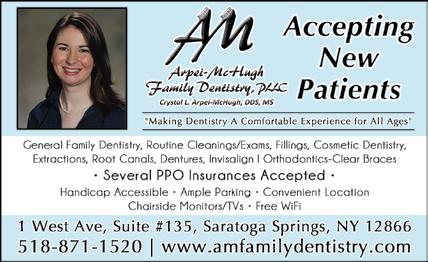
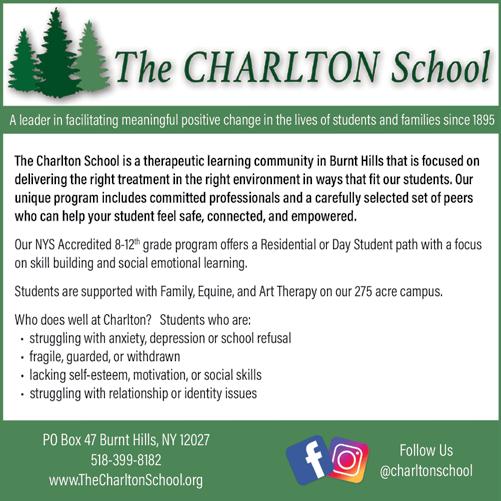
WRITTEN BY JENNIFER LEFNER, MD, CHIEF OF NEWBORN
MEDICINE, CHAIR OF PEDIATRICS, SARATOGA HOSPITAL MEDICAL GROUP –NEONATOLOGY
Holidays and small children go hand-in-hand. Grandparents often plan all year long to celebrate with their grandchildren. Now, in the middle of a combined pandemic and flu season, families are finding ways to do things a little differently, such as spending time together from a distance. The safest thing for families is not to travel “over the river and through the woods” to grandmother’s or anyone else’s house this year. We even recommend no pictures with Santa or taking children to see holiday-dressed store windows. I know how disappointing this must be, but we all have to be very careful about attending or holding family gatherings, even small ones. Much of the spread of COVID-19 is happening among relatives and friends who let their guard down, hug each other, or leave off their masks. That is especially risky around small children, because they cannot wear masks until age 2. We have to keep our grandparents safe, too. While there have been very few studies showing grandparents being infected with an illness from contact with a baby, the baby’s parents or older siblings could pose a risk. The reverse, however, of a grandparent or other adult infecting a baby is all too common. Those illnesses typically include COVID-19, flu, respiratory syncytial virus(RSV), and pertussis (whooping cough). As a neonatologist, I have the pleasure of seeing newborns welcomed into the arms of their parents. I also have the responsibility of helping families understand how to keep them safe from infection, especially at such a vulnerable age. Here are some precautions that may help mitigate the risk of infection for everyone in your family. First, whether you are celebrating the holidays or introducing your new baby, try choosing to enjoy your extended family from a distance. Just about everyone is using video technology such as FaceTime and Zoom for virtual visits and parties these days. Another option is to hold an “open house,” where visitors come, one at a time, up to a window to see your newborn or small children while they wave, serenade, or hold up celebratory signs. You and your children can also have a meet-and-greet with visitors from your front doorway, as long as they are masked and standing outside, at least six feet away.

If you choose to welcome one or two visitors inside, I recommend the following checklist to make sure the visit is as safe as possible:
Jennifer Lefner, MD, Chief of Newborn Medicine, Chair of Pediatrics, Saratoga Hospital Medical Group –Neonatology • Visitors must not have any symptoms of COVID-19, flu, or any contagion. • Strongly recommend visitors have a flu shot and be caught up on their vaccines, such as a Tdap (tetanus, diphtheria, pertussis) booster if they have not had one in a while. • Visitors from out of state must abide by New York State COVID-19 travel and quarantine rules as listed on the New York State Department of Health website. • Visitors who have been confirmed COVID-negative must have received the test results within three days of the visit. • Ask visitors to self-quarantine for two weeks before they visit: meaning no shopping, everything delivered, and no contact with anyone outside their household for 14 days without exception. • Visitors must wash their hands, use hand sanitizer, and wear masks that cover both the nose and the mouth. Bandanas and neck gaiters are not acceptable. • Move your furniture 6 feet apart and mark tape on the floor in standing areas, like the kitchen. None of these precautions can keep you from having a good time, and all of them can give you better peace of mind. No one wants to spend the holidays sick. There are many additional resources available for families who want to enjoy visitors while keeping their family members safe, such as Healthychildren.org, provided by the American Academy of Pediatrics. For more information about Saratoga Hospital Medical Group – Neonatology, visit SaratogaHospital.org. And from all of us here at Saratoga Hospital, best wishes for a safe and happy holiday season!
Them’s the breaks ... and the fractures ...and the sprains . . . and other ortho pains!
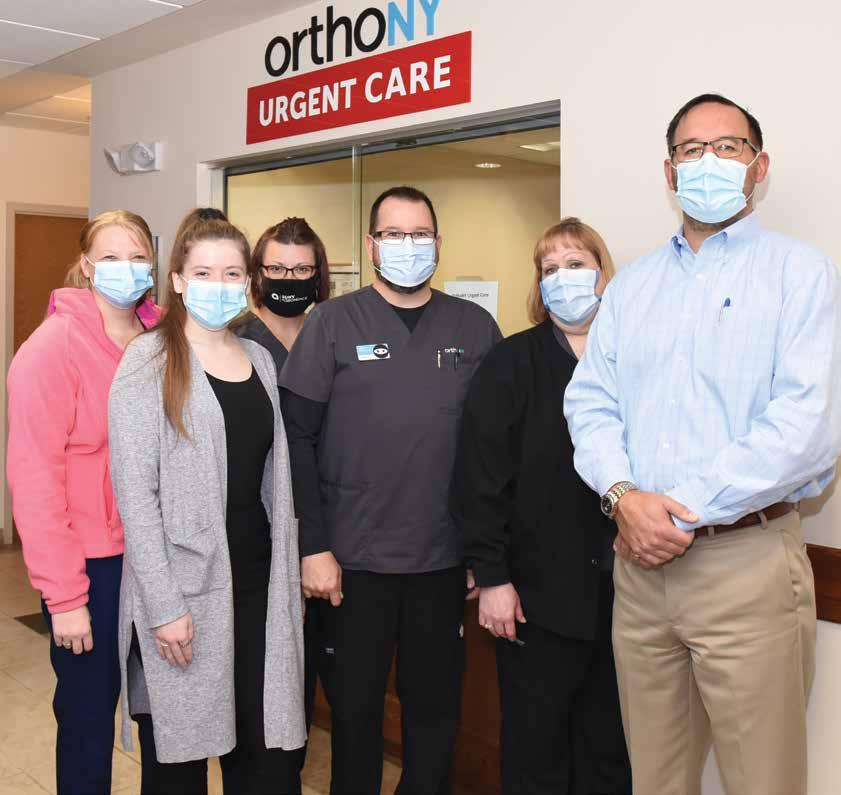
WRITTEN BY ANN HAUPRICH PHOTOS BY SUPERSOURCEMEDIA.COM
The phrase “them’s the breaks” comes from the game of pool or billiards. When the balls are racked up in formation and one player ‘breaks’ or takes the first shot to try and send the balls around the table. The result of this break reportedly cannot be changed, and the players must make do with what they are given. Fortunately for those who find themselves in the care of OrthoNY specialists like Dr. Jonathan Gainor, expressions like “them’s the breaks” have an entirely different meaning. The orthopedic breaks can, in fact, be changed and patients are never expected to make do with the results of the accident or injury that led them to the practice. Any “shots” that might need to be administered involve treatment plans aimed at providing the best possible outcome that will ensure a rapid return to a normal and rewarding lifestyle. In addition to breaks, fractures and sprains, the group of 41 board certified and fellowship trained orthopedic surgeons affiliated with the highly specialized practice that has a dozen locations throughout the greater Saratoga-Capital region also performs thousands of hip and knee replacements annually. Helping to ensure bones and joints mend properly are 24 physicians’ assistants and nurse practitioners plus a dozen physical therapists, all with extensive experience providing sub-specialized orthopedic care.
“Joint replacement is very successful at improving the Therapy is a rebalancing of the body and muscles. The literature lives of patients with pain from arthritis, traumatic injury, clearly shows positive benefits for arthritis with physical therapy. developmental defects, and other conditions that can lead Yes, until that wand becomes available, I still am needed as a to crippling joint pain,” explains Dr. Gainor. “Across our surgeon. Surgical techniques have become less invasive over three regions and multiple hospital systems, as well as our the years. We are now sending our hip and knee replacement outpatient surgical centers we are busy doing up to eight joint patients home the same day of their surgery. They are recovering replacements a day per surgeon. That math adds up to many faster than ever from this surgery. I am amazed at how far joint happy patients enjoying life and being pain free.” replacement has come in the last decade,” marvels Dr. Gainor. While Dr. Gainor has performed hip replacement operations on Speaking of Star Trek, some patients reportedly felt as if they patients ranging in age from 18 to 96, he doesn’t like the concept had wandered onto a sci-fi movie set when they arrived for of surgical candidates being categorized as too young or too appointments at OrthoNY after Governor Andrew Cuomo old. “Every patient is an individual not declared a State of Emergency in March 2020 a number on a calendar. You are either in an attempt to help prevent the spread healthy enough or not.” "The therapist is going of the coronavirus. In fact, the pandemic Although there were still no Star Trek to find what is weak and impacted OrthoNY in additional ways. Voyager Wands that could magically strengthen it, and they will “With the complete shutdown of the heal patients as 2020 was drawing to a close, Dr. Gainor emphasized that not all OrthoNY treatments are surgical in nature. “As people live long and prosper find what is tight and stretch it. Therapy is a rebalancing of the body and muscles. world due to COVID, our practice came to a screeching halt. Elective surgeries were canceled and the world stopped moving. Literally, people stopped going out and the things wear out and begin to hurt. There The literature clearly shows number of people having orthopedic injuries are always new medications coming to market for treatment of orthopedic conditions. I call those the potions, positive benefits for arthritis with physical therapy. " dropped off. PPE shortages were never an issue as we started the immediate rationing of supplies. We had enough supplies during lotions, and pills. They are a great place the shutdown, but there was constant to start. Injections have been around for communication of our situation across all a long time. Everyone seems to know cortisone, but the reality is regions. The benefit of a larger practice, if one region ran low, I have never injected cortisone. It’s a generic term for the steroid we can shift things around. Our practice did an amazing job of we inject. So better injections with better results than the classic keeping supplies on the shelf so we could remain operational and cortisone. No one likes needles, but they are less invasive than continue to serve our community,” explains Gainor. “Thankfully, surgery. There are lubricating injections that can be given as well.” we were able to keep a supply of PPE and could allow the In an interesting twist, Dr. Gainor says physical therapy is the hardest treatment option to sell to someone in pain. “People get confused about what therapy is. It is not exercise. It is quite the opposite. The therapist is going to find what is weak and strengthen it, and they will find what is tight and stretch it. wonderful volunteers to give to others in need. Global Foundries had PPE for donation (thank you Greg Connors), Best Dressed Windows in Town (Michele Erceg) made countless masks and never took a penny for her efforts. There were many others that I don’t even know about. These silent contributors gave their time and materials to keep us safe.
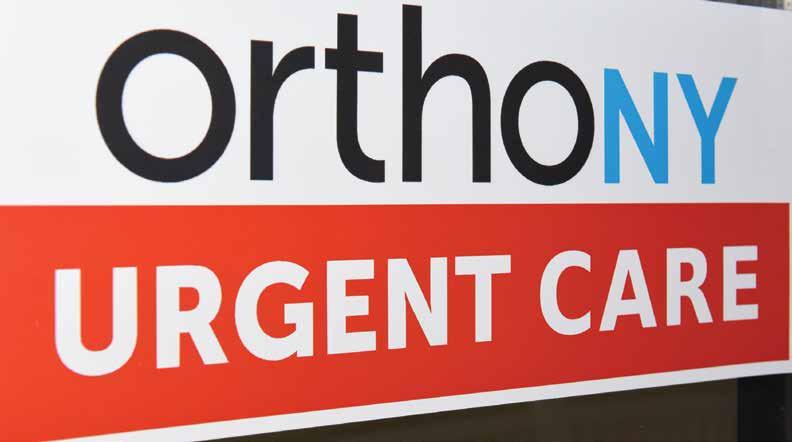
In keeping with ongoing mandatory NYS guidelines for protection against COVID, masks and social distancing remain immediately noticeable, but much additional work goes on behind the scenes at OrthoNY, which was formed several years ago by a merger of Orthopedic Associates of Saratoga and Northeast Orthopedics. “Management has had regular meeting with NYS DOH to stay up to date with the quickly changing protocols. Early on we limited the number of people in the building. It was one patient in a room, one in the waiting area, and the rest waiting in their car. Strange times for sure. As of late October, we were seeing a more regular schedule of patients, but we must continue to limit the number of people in the building. No mask, no entry is the NYS mandate that we enforce. There have also been cleaning protocols put in place, so all surfaces are wiped down with special cleansers between each patient visit and common areas are cleaned multiple times during the day. Temperature checks on everyone, employees and patients, prevent anyone with a fever from entering the building,” says Dr. Gainor. Of course, not all patients have the option of advance planning when it comes to needing orthopedic care. That’s where OrthoNY’s specialized urgent care centers, including those in Albany, Clifton Park, Saratoga Springs and Schenectady come into orbit. “This is an active region,” notes Dr. Gainor. “People get hurt and our walk-in urgent care allows immediate access to an orthopedic professional. Regular urgent cares and emergency rooms can splint and immobilize but they will most often recommend you follow up with an orthopedic practice. Specialized urgent care makes it possible to skip the extra step -- and in today’s environment -- the extra copay.” To learn more visit www.orthony.com. Steps in the direction of resilience… If Dr. Jonathan Gainor could have an inspiring message imprinted on the front of his favorite face mask, it would read RESILIENCE. “There are so many challenges in life, even before a virus shut the world down. If we catastrophize the events that challenge us, we lose before we start. I believe in the science of inertia. An object at rest will stay at rest. Take the first step, whatever that means in your world, once in motion an object will stay in motion. Use your resilience to not let those outside forces stop your momentum,” advises the orthopedic surgeon. The hardest part of the New Normal for OrthoNY specialists has been the loss of the emotional bond that develops with the patients. “Putting a mask over our face removes a large portion of body language. A smile can go a long way to comforting someone. Not having family members present in office consultations of even after a surgery is very different for me. When I come out of an OR and talk face to face with a family member, I see them relax and feel better after we talk. I know that they are comfortable and have had their questions answered.” Someday soon…

